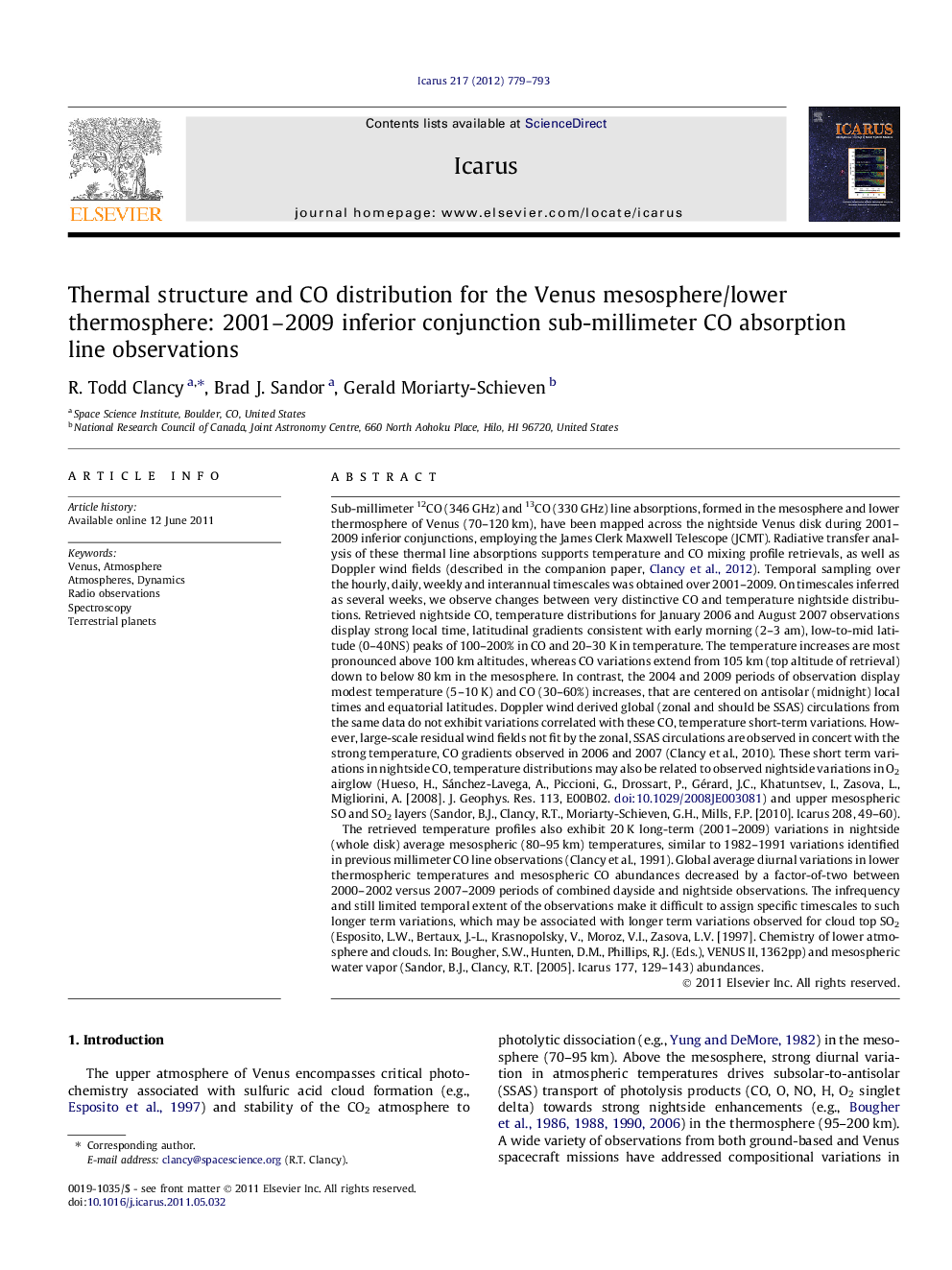| کد مقاله | کد نشریه | سال انتشار | مقاله انگلیسی | نسخه تمام متن |
|---|---|---|---|---|
| 1773700 | 1021143 | 2012 | 15 صفحه PDF | دانلود رایگان |

Sub-millimeter 12CO (346 GHz) and 13CO (330 GHz) line absorptions, formed in the mesosphere and lower thermosphere of Venus (70–120 km), have been mapped across the nightside Venus disk during 2001–2009 inferior conjunctions, employing the James Clerk Maxwell Telescope (JCMT). Radiative transfer analysis of these thermal line absorptions supports temperature and CO mixing profile retrievals, as well as Doppler wind fields (described in the companion paper, Clancy et al., 2012). Temporal sampling over the hourly, daily, weekly and interannual timescales was obtained over 2001–2009. On timescales inferred as several weeks, we observe changes between very distinctive CO and temperature nightside distributions. Retrieved nightside CO, temperature distributions for January 2006 and August 2007 observations display strong local time, latitudinal gradients consistent with early morning (2–3 am), low-to-mid latitude (0–40NS) peaks of 100–200% in CO and 20–30 K in temperature. The temperature increases are most pronounced above 100 km altitudes, whereas CO variations extend from 105 km (top altitude of retrieval) down to below 80 km in the mesosphere. In contrast, the 2004 and 2009 periods of observation display modest temperature (5–10 K) and CO (30–60%) increases, that are centered on antisolar (midnight) local times and equatorial latitudes. Doppler wind derived global (zonal and should be SSAS) circulations from the same data do not exhibit variations correlated with these CO, temperature short-term variations. However, large-scale residual wind fields not fit by the zonal, SSAS circulations are observed in concert with the strong temperature, CO gradients observed in 2006 and 2007 (Clancy et al., 2010). These short term variations in nightside CO, temperature distributions may also be related to observed nightside variations in O2 airglow (Hueso, H., Sánchez-Lavega, A., Piccioni, G., Drossart, P., Gérard, J.C., Khatuntsev, I., Zasova, L., Migliorini, A. [2008]. J. Geophys. Res. 113, E00B02. doi:10.1029/2008JE003081) and upper mesospheric SO and SO2 layers (Sandor, B.J., Clancy, R.T., Moriarty-Schieven, G.H., Mills, F.P. [2010]. Icarus 208, 49–60).The retrieved temperature profiles also exhibit 20 K long-term (2001–2009) variations in nightside (whole disk) average mesospheric (80–95 km) temperatures, similar to 1982–1991 variations identified in previous millimeter CO line observations (Clancy et al., 1991). Global average diurnal variations in lower thermospheric temperatures and mesospheric CO abundances decreased by a factor-of-two between 2000–2002 versus 2007–2009 periods of combined dayside and nightside observations. The infrequency and still limited temporal extent of the observations make it difficult to assign specific timescales to such longer term variations, which may be associated with longer term variations observed for cloud top SO2 (Esposito, L.W., Bertaux, J.-L., Krasnopolsky, V., Moroz, V.I., Zasova, L.V. [1997]. Chemistry of lower atmosphere and clouds. In: Bougher, S.W., Hunten, D.M., Phillips, R.J. (Eds.), VENUS II, 1362pp) and mesospheric water vapor (Sandor, B.J., Clancy, R.T. [2005]. Icarus 177, 129–143) abundances.
► Very strong nightside peaks in temperature and CO abundance appear and disappear in the Venus lower thermosphere on several week timescales.
► These variations do not correlate with variations in the large-scale zonal and sub-solar-to-antisolar circulation fields.
► Temporal variations in a smaller-scale nightside residual circulation may account for the lower thermospheric CO and temperature variabilities.
► Variations in global average temperatures and CO abundances in the Venus mesosphere and lower thermosphere occur over several year timescales.
Journal: Icarus - Volume 217, Issue 2, February 2012, Pages 779–793